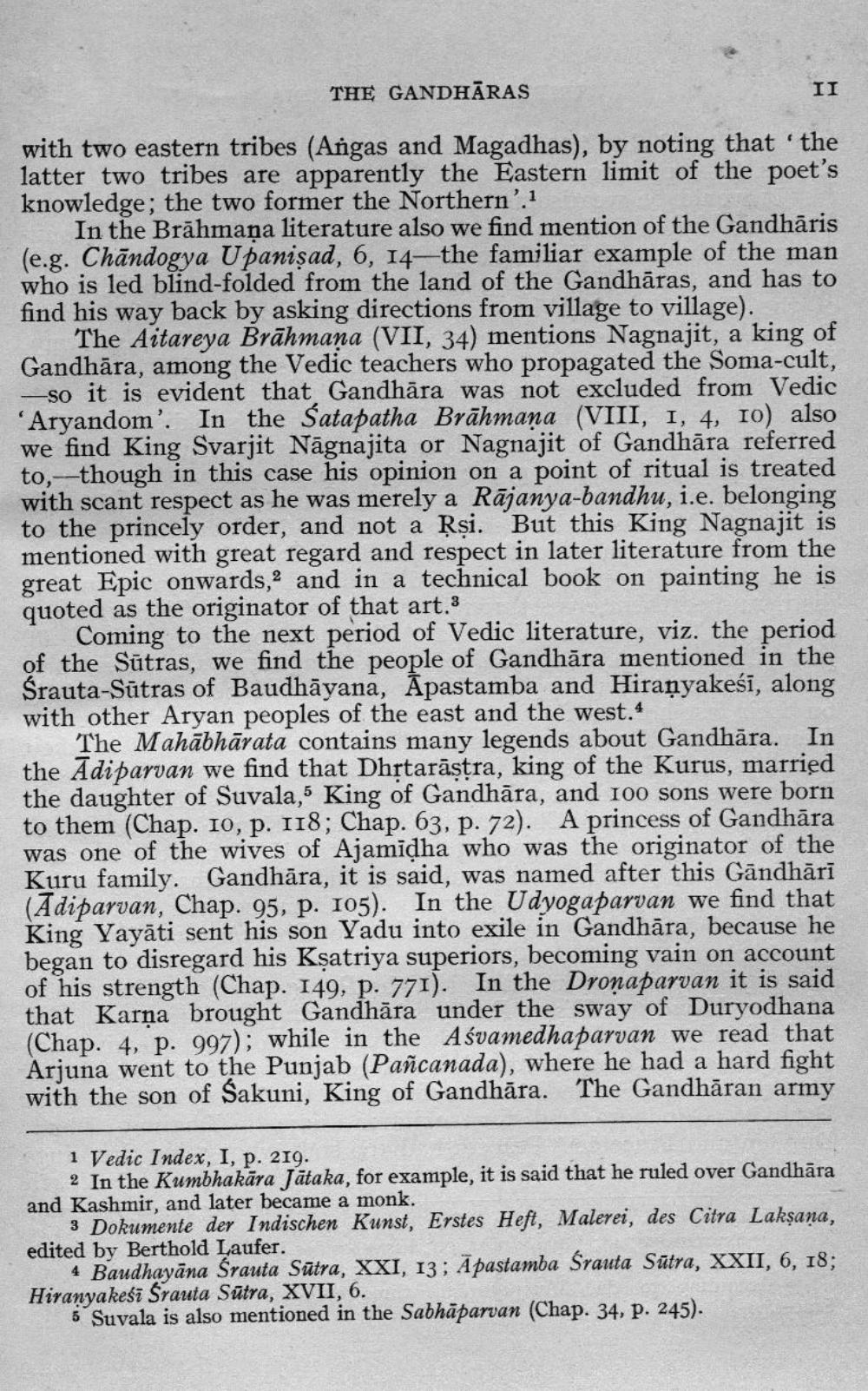________________
THE GANDHĀRAS
II
with two eastern tribes (Argas and Magadhas), by noting that the latter two tribes are apparently the Eastern limit of the poet's knowledge; the two former the Northern'.1
In the Brāhmaṇa literature also we find mention of the Gandhāris (e.g. Chāndogya Upanişad, 6, 14—the familiar example of the man who is led blind-folded from the land of the Gandhāras, and has to find his way back by asking directions from village to village).
The Aitareya Brāhmaṇa (VII, 34) mentions Nagnajit, a king of Gandhāra, among the Vedic teachers who propagated the Soma-cult,
-so it is evident that Gandhāra was not excluded from Vedic 'Aryandom'. In the Śatapatha Brāhmana (VIII, I, 4, 10) also we find King Svarjit Nāgnajita or Nagnajit of Gandhāra referred to,--though in this case his opinion on a point of ritual is treated with scant respect as he was merely a Rājanya-bandhu, i.e. belonging to the princely order, and not a Rsi. But this King Nagnajit is mentioned with great regard and respect in later literature from the great Epic onwards, and in a technical book on painting he is quoted as the originator of that art.3
Coming to the next period of Vedic literature, viz. the period of the Sūtras, we find the people of Gandhāra mentioned in the Śrauta-Sūtras of Baudhāyana, Āpastamba and Hiraṇyakeśī, along with other Aryan peoples of the east and the west.4
The Mahābhārata contains many legends about Gandhāra. In the Ādiparvan we find that Dhrtarāstra, king of the Kurus, married the daughter of Suvala,5 King of Gandhāra, and 100 sons were born to them (Chap. 10, p. 118; Chap. 63, p. 72). A princess of Gandhāra was one of the wives of Ajamidha who was the originator of the Kuru family. Gandhāra, it is said, was named after this Gāndhāri (Adiparvan, Chap. 95, p. 105). In the Udyogaparvan we find that King Yayāti sent his son Vadu into exile in Gandhāra, because he began to disregard his Ksatriya superiors, becoming vain on account of his strength (Chap. 149, p. 771). In the Dronaparvan it is said that Karņa brought Gandhāra under the sway of Duryodhana (Chap. 4, p. 997); while in the Aśvamedha parvan we read that Arjuna went to the Punjab (Pañcanada), where he had a hard fight with the son of Sakuni, King of Gandhāra. The Gandhāran army
1 Vedic Index, I, p. 219.
2 In the Kumbhakāra sātaka, for example, it is said that he ruled over Gandhāra and Kashmir, and later became a monk.
3 Dokumente der Indischen Kunst, Erstes Heft, Malerei, des Citra Laksana, edited by Berthold Laufer.
4 Baudhayāna Śrauta Sūtra, XXI, 13; Āpastamba Srauta Sūtra, XXII, 6, 18; Hiranyakeśī Srauta Sätra, XVII, 6.
5 Suvala is also mentioned in the Sabhāparvan (Chap. 34, p. 245).




